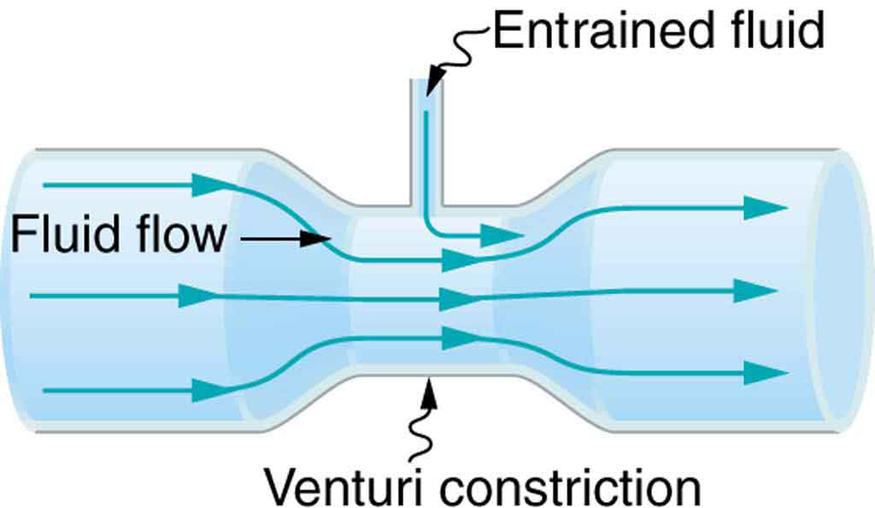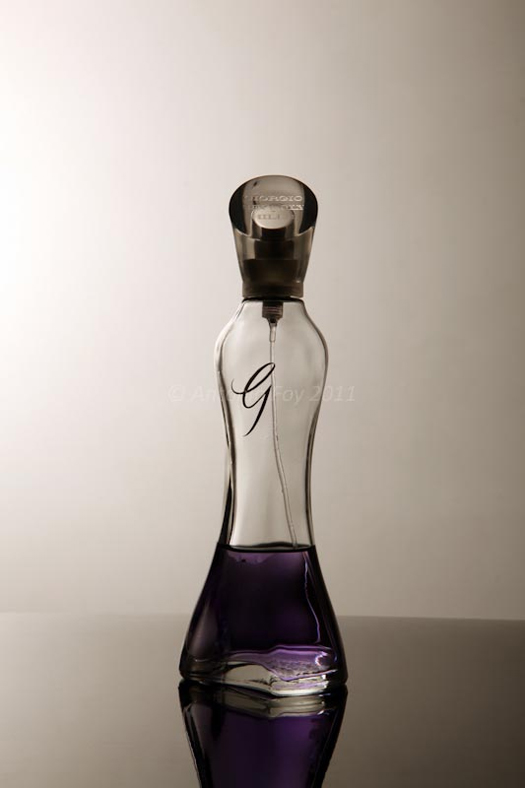| << Chapter < Page | Chapter >> Page > |
You can squirt water a considerably greater distance by placing your thumb over the end of a garden hose and then releasing, than by leaving it completely uncovered. Explain how this works.
Water is shot nearly vertically upward in a decorative fountain and the stream is observed to broaden as it rises. Conversely, a stream of water falling straight down from a faucet narrows. Explain why, and discuss whether surface tension enhances or reduces the effect in each case.
Look back to [link] . Answer the following two questions. Why is less than atmospheric? Why is greater than ?
Give an example of entrainment not mentioned in the text.
Many entrainment devices have a constriction, called a Venturi, such as shown in [link] . How does this bolster entrainment?

Some chimney pipes have a T-shape, with a crosspiece on top that helps draw up gases whenever there is even a slight breeze. Explain how this works in terms of Bernoulli's principle.
Is there a limit to the height to which an entrainment device can raise a fluid? Explain your answer.
Why is it preferable for airplanes to take off into the wind rather than with the wind?
Roofs are sometimes pushed off vertically during a tropical cyclone, and buildings sometimes explode outward when hit by a tornado. Use Bernoulli's principle to explain these phenomena.
Why does a sailboat need a keel?
It is dangerous to stand close to railroad tracks when a rapidly moving commuter train passes. Explain why atmospheric pressure would push you toward the moving train.
Water pressure inside a hose nozzle can be less than atmospheric pressure due to the Bernoulli effect. Explain in terms of energy how the water can emerge from the nozzle against the opposing atmospheric pressure.
A perfume bottle or atomizer sprays a fluid that is in the bottle. ( [link] .) How does the fluid rise up in the vertical tube in the bottle?

If you lower the window on a car while moving, an empty plastic bag can sometimes fly out the window. Why does this happen?
Suppose you have a wind speed gauge like the pitot tube shown in [link] (b). By what factor must wind speed increase to double the value of in the manometer? Is this independent of the moving fluid and the fluid in the manometer?
If the pressure reading of your pitot tube is 15.0 mm Hg at a speed of 200 km/h, what will it be at 700 km/h at the same altitude?
184 mm Hg
Calculate the maximum height to which water could be squirted with the hose in [link] example if it: (a) Emerges from the nozzle. (b) Emerges with the nozzle removed, assuming the same flow rate.
Every few years, winds in Boulder, Colorado, attain sustained speeds of 45.0 m/s (about 100 mi/h) when the jet stream descends during early spring. Approximately what is the force due to the Bernoulli effect on a roof having an area of ? Typical air density in Boulder is , and the corresponding atmospheric pressure is . (Bernoulli's principle as stated in the text assumes laminar flow. Using the principle here produces only an approximate result, because there is significant turbulence.)
(a) Calculate the approximate force on a square meter of sail, given the horizontal velocity of the wind is 6.00 m/s parallel to its front surface and 3.50 m/s along its back surface. Take the density of air to be . (The calculation, based on Bernoulli's principle, is approximate due to the effects of turbulence.) (b) Discuss whether this force is great enough to be effective for propelling a sailboat.
(a) What is the pressure drop due to the Bernoulli effect as water goes into a 3.00-cm-diameter nozzle from a 9.00-cm-diameter fire hose while carrying a flow of 40.0 L/s? (b) To what maximum height above the nozzle can this water rise? (The actual height will be significantly smaller due to air resistance.)
(a)
(b) 163 m
(a) Using Bernoulli's equation, show that the measured fluid speed for a pitot tube, like the one in [link] (b), is given by
where is the height of the manometer fluid, is the density of the manometer fluid, is the density of the moving fluid, and is the acceleration due to gravity. (Note that is indeed proportional to the square root of , as stated in the text.) (b) Calculate for moving air if a mercury manometer's is 0.200 m.
At what depth beneath the surface of the lake is the pressure in the water equal to twice atmospheric pressure?
(a)
A pump provides pressure to the lower end of a long pipeline that supplies water from a reservoir to a house located on a hill 150 m vertically upward from the lower end of the pipe (where the water is initially at rest before being pumped). The pipeline has a constant diameter of 3.5 cm, and the upper end of the pipeline is open to the atmosphere. What pressure must the pump provide for water to flow from the upper end of the pipeline at a rate of 5.0 m/s?
According to Bernoulli's equation, if the pressure in a given fluid is constant and the kinetic energy per unit volume of a fluid increases, which of the following is true?
(a)
Consider the following circumstances within a fluid, and determine the answer using Bernoulli's equation. (a) The pressure and kinetic energy per unit volume along a fluid path increases. What must be true about the potential energy per unit volume of the fluid along the fluid path? Explain. (b) The pressure along a fluid path increases, and the kinetic energy per unit volume remains constant. What must be true about the potential energy per unit volume of the fluid along the fluid path? Explain.

Notification Switch
Would you like to follow the 'College physics for ap® courses' conversation and receive update notifications?